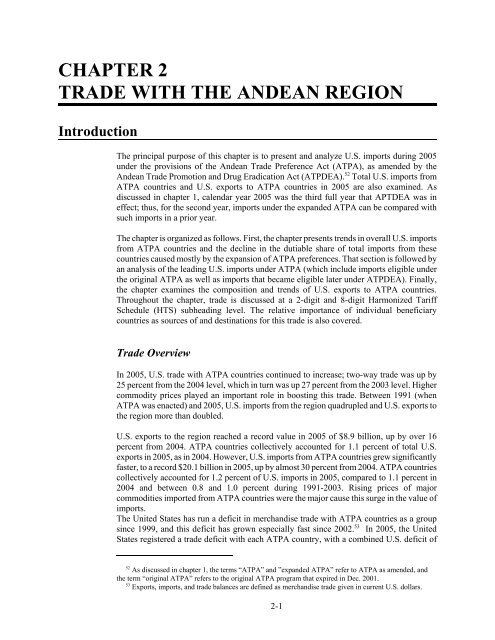analysis assumes that <strong>the</strong> supply <strong>of</strong> U.S. domestic production is perfectly elastic; that is, U.S.domestic prices do not fall in response to ATPA duty reductions. Thus, price-relateddecreases in U.S. producer surplus are not captured in this analysis. However, <strong>the</strong> effects <strong>of</strong>ATPA duty reductions on most U.S. industries are expected to be small.This analysis estimates potential net welfare effects and industry displacement, and <strong>the</strong>seestimates reflect a range <strong>of</strong> assumed substitutabilities between ATPA products andcompeting U.S. output. <strong>The</strong> upper estimates reflect <strong>the</strong> assumption <strong>of</strong> high substitutionelasticities, 50 whereas <strong>the</strong> lower estimates reflect <strong>the</strong> assumption <strong>of</strong> low substitutionelasticities. Upper estimates are used to identify items that could be most affected by ATPA.<strong>The</strong> Commission’s analysis covers <strong>the</strong> 20 leading items that benefited exclusively fromATPA tariff preferences. 51 <strong>The</strong> analysis provides estimates <strong>of</strong> welfare and potential U.S.industry displacement. Industries for which estimated upper potential displacement is morethan 5 percent <strong>of</strong> <strong>the</strong> value <strong>of</strong> U.S. production are selected for fur<strong>the</strong>r analysis.Commission analysis <strong>of</strong> <strong>the</strong> probable future effects <strong>of</strong> ATPA is based on a qualitativeanalysis <strong>of</strong> economic trends and investment patterns in beneficiary countries and incompeting U.S. industries. <strong>The</strong> primary sources for information on investment in ATPArelatedproduction facilities are U.S. embassies in <strong>the</strong> region and published sources. Toassess <strong>the</strong> estimated effect <strong>of</strong> ATPA on <strong>the</strong> drug-crop eradication and crop substitutionefforts <strong>of</strong> <strong>the</strong> beneficiary countries, <strong>the</strong> Commission relied primarily on information fromo<strong>the</strong>r U.S. Government agencies, such as <strong>the</strong> Department <strong>of</strong> State and <strong>the</strong> Agency forInternational Development (USAID), as well as o<strong>the</strong>r published sources.49(...continued)entrepreneurs and owners <strong>of</strong> capital that exceeds earnings for <strong>the</strong>ir next-best opportunities. See WalterNicholson, Microeconomic <strong>The</strong>ory: Basic Principles and Extensions (New York: Dryden Press, 1989), forfur<strong>the</strong>r discussion <strong>of</strong> consumer and producer surplus. <strong>The</strong> welfare effects do not include short-run adjustmentcosts to <strong>the</strong> economy from reallocating resources among different industries.50Commission industry analysts provided evaluations <strong>of</strong> <strong>the</strong> substitutability <strong>of</strong> ATPA products andcompeting U.S. products, which were translated into a range <strong>of</strong> substitution elasticities—3 to 5 for highsubstitutability, 2 to 4 for medium, and 1 to 3 for low. Although <strong>the</strong>re is no <strong>the</strong>oretical upper limit toelasticities <strong>of</strong> substitution, a substitution elasticity <strong>of</strong> 5 is consistent with <strong>the</strong> upper range <strong>of</strong> estimates in <strong>the</strong>economics literature. Estimates in <strong>the</strong> literature tend to be predominantly lower. See, for example, Clinton R.Shiells, Robert M. Stern, and Alan V. Deardorff, “Estimates <strong>of</strong> <strong>the</strong> Elasticities <strong>of</strong> Substitution BetweenImports and Home Goods for <strong>the</strong> United States,” Weltwirtschaftliches Archiv, 122 (1986), pp. 497-519; andMichael P. Gallaway, Christine A. McDaniel, and Sandra A. Rivera, “Short-Run and Long-Run Estimates <strong>of</strong>U.S. Armington Elasticities,” North American Journal <strong>of</strong> Economics and Finance, 14 (2003), pp. 49-68.51See table 3-2 in chapter 3. Commission industry analysts provided estimates <strong>of</strong> U.S. production andexports for <strong>the</strong> 20 leading items that benefited exclusively from ATPA, as well as evaluations <strong>of</strong> <strong>the</strong>substitutability <strong>of</strong> ATPA-exclusive imports and competing U.S. products. Items were ranked at <strong>the</strong> 8-digitlevel <strong>of</strong> HTS tariff classification.1-10
CHAPTER 2TRADE WITH THE ANDEAN REGIONIntroduction<strong>The</strong> principal purpose <strong>of</strong> this chapter is to present and analyze U.S. imports during 2005under <strong>the</strong> provisions <strong>of</strong> <strong>the</strong> <strong>Andean</strong> <strong>Trade</strong> <strong>Preference</strong> <strong>Act</strong> (ATPA), as amended by <strong>the</strong><strong>Andean</strong> <strong>Trade</strong> Promotion and Drug Eradication <strong>Act</strong> (ATPDEA). 52 Total U.S. imports fromATPA countries and U.S. exports to ATPA countries in 2005 are also examined. Asdiscussed in chapter 1, calendar year 2005 was <strong>the</strong> third full year that APTDEA was ineffect; thus, for <strong>the</strong> second year, imports under <strong>the</strong> expanded ATPA can be compared withsuch imports in a prior year.<strong>The</strong> chapter is organized as follows. First, <strong>the</strong> chapter presents trends in overall U.S. importsfrom ATPA countries and <strong>the</strong> decline in <strong>the</strong> dutiable share <strong>of</strong> total imports from <strong>the</strong>secountries caused mostly by <strong>the</strong> expansion <strong>of</strong> ATPA preferences. That section is followed byan analysis <strong>of</strong> <strong>the</strong> leading U.S. imports under ATPA (which include imports eligible under<strong>the</strong> original ATPA as well as imports that became eligible later under ATPDEA). Finally,<strong>the</strong> chapter examines <strong>the</strong> composition and trends <strong>of</strong> U.S. exports to ATPA countries.Throughout <strong>the</strong> chapter, trade is discussed at a 2-digit and 8-digit Harmonized TariffSchedule (HTS) subheading level. <strong>The</strong> relative importance <strong>of</strong> individual beneficiarycountries as sources <strong>of</strong> and destinations for this trade is also covered.<strong>Trade</strong> OverviewIn 2005, U.S. trade with ATPA countries continued to increase; two-way trade was up by25 percent from <strong>the</strong> 2004 level, which in turn was up 27 percent from <strong>the</strong> 2003 level. Highercommodity prices played an important role in boosting this trade. Between 1991 (whenATPA was enacted) and 2005, U.S. imports from <strong>the</strong> region quadrupled and U.S. exports to<strong>the</strong> region more than doubled.U.S. exports to <strong>the</strong> region reached a record value in 2005 <strong>of</strong> $8.9 billion, up by over 16percent from 2004. ATPA countries collectively accounted for 1.1 percent <strong>of</strong> total U.S.exports in 2005, as in 2004. However, U.S. imports from ATPA countries grew significantlyfaster, to a record $20.1 billion in 2005, up by almost 30 percent from 2004. ATPA countriescollectively accounted for 1.2 percent <strong>of</strong> U.S. imports in 2005, compared to 1.1 percent in2004 and between 0.8 and 1.0 percent during 1991-2003. Rising prices <strong>of</strong> majorcommodities imported from ATPA countries were <strong>the</strong> major cause this surge in <strong>the</strong> value <strong>of</strong>imports.<strong>The</strong> United States has run a deficit in merchandise trade with ATPA countries as a groupsince 1999, and this deficit has grown especially fast since 2002. 53 In 2005, <strong>the</strong> UnitedStates registered a trade deficit with each ATPA country, with a combined U.S. deficit <strong>of</strong>52As discussed in chapter 1, <strong>the</strong> terms “ATPA” and ”expanded ATPA” refer to ATPA as amended, and<strong>the</strong> term “original ATPA” refers to <strong>the</strong> original ATPA program that expired in Dec. 2001.53 Exports, imports, and trade balances are defined as merchandise trade given in current U.S. dollars.2-1
















